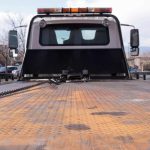From the bustling M25 to the scenic M1, driving on the UK’s extensive motorway network is an everyday reality for millions of drivers. But what happens when things go wrong and your vehicle breaks down? A vehicle breakdown on a high-speed motorway can be a nerve-wracking experience, even for seasoned drivers. It’s an emergency situation that requires quick thinking, calmness, and a clear understanding of safety procedures. In this guide, we’ll cover step-by-step instructions on how to manage this challenging situation safely, effectively, and within the UK law’s guidelines.
Identify the Signs of a Breakdown
The first step in handling a breakdown is recognising when your vehicle is having a problem. Often, your car will give warning lights or signals that something is wrong before it breaks down. Keep an eye on your dashboard and listen for any unfamiliar noises. If your car starts to behave strangely – for instance, if it loses power, if the steering becomes hard, or if you notice an unusual smell – it’s likely that a breakdown is imminent.
Also to discover : What are the top safety features to look for in a new car in the UK?
In such a case, try to remain calm and begin to prepare for a safe exit from the motorway. Never ignore these warning signs; doing so could put you and other road users at risk.
Safely Pull Over
If your vehicle shows signs of impending failure, your priority should be to get out of traffic and move to a safer location. The standard procedure in the UK is to move to the left-hand side of the motorway. Try to reach an emergency refuge area (ERA), motorway service area, or exit to a slip road if possible.
Have you seen this : How to check if a vehicle is subject to a recall in the UK?
If you cannot reach these safe areas, pull over onto the hard shoulder. If there’s a barrier, keep your vehicle as far to the left as possible. Once stopped, switch on your vehicle’s hazard warning lights to signal other road users of your situation. If it’s dark or visibility is poor, also use side lights to make your vehicle more visible.
Exit the Vehicle Safely
After you’ve successfully pulled over, it’s crucial that everyone in the vehicle exits safely. This might seem counterintuitive, especially when traffic is speeding by, but it’s safer outside the vehicle than inside it if an accident occurs.
Exit the vehicle from the left-hand side to avoid the traffic. Make sure everyone in the vehicle does the same. If you have a reflective jacket or a traffic cone, use it to make yourself more visible to passing vehicles. If not, stay as far away from the vehicle and passing traffic as you can, preferably behind a safety barrier.
Call for Help
Once everyone is safely out of the vehicle and at a safe distance, it’s time to call for help. Use your mobile phone to call your breakdown cover provider. If you don’t have a mobile phone or it’s not working, use the nearest emergency telephone. These are located every mile along the motorway and connect directly to the Highways England control centre.
Provide them with all the necessary details about your location and the nature of your breakdown. They will send out an emergency service vehicle to assist you. Never attempt to fix the vehicle yourself on the motorway; it’s both dangerous and against the law.
Stay Safe while Waiting
While waiting for help to arrive, it’s important to keep safe. Stay well away from the carriageway and hard shoulder. Keep children under control and away from the traffic. Do not return to your vehicle unless it’s absolutely necessary.
If you feel threatened in any way – for instance, if someone stops and behaves suspiciously – return to your vehicle via the left-hand side and lock all doors. If this happens, or if there is another emergency, call the emergency services.
Navigating a vehicle breakdown on UK motorways doesn’t have to be a daunting task. By following these guidelines, you’ll be well-prepared to handle such incidents with confidence and safety-awareness. Remember, your safety and the safety of other road users should always come first in such scenarios.
Use the Warning Triangle
Once you’ve called for help, it’s time to make your car’s presence known to other road users. If your vehicle has a warning triangle, this is the perfect time to use it. This simple device can substantially increase your visibility to other drivers, reducing the likelihood of an accident.
If you don’t have a warning triangle, it’s a good idea to invest in one. They’re inexpensive, easy to use, and can be lifesaving in a breakdown situation. To deploy the warning triangle, walk about 45 meters along the motorway from the rear of your vehicle in the direction of the traffic. This is roughly the same as 147 feet or about 50 paces. Place the triangle on the verge if there is one, or on the hard shoulder if not.
Do not attempt to use a warning triangle if you’re on the hard shoulder of a smart motorway. The risk to road users from rapidly moving traffic is too high. In this case, your vehicle’s hazard lights and any additional lighting such as side lights should suffice.
It’s also worth noting that it’s illegal to use flares or other pyrotechnic devices to signal your breakdown. These can cause panic, confusion, and even accidents, so stick to a warning triangle and your vehicle’s built-in lighting.
Communicate with the Emergency Services
After deploying your warning triangle or turning on your hazard lights, it’s time to communicate with the emergency services. If you have a mobile phone, call the emergency number provided by your breakdown cover provider or dial 999 for immediate assistance.
If you don’t have a mobile phone or it’s not working, look for the nearest emergency telephone. These are located every mile along the motorway, usually marked with a blue sign bearing a white telephone symbol. Press the SOS button and you’ll be connected to the Highways England control centre.
When you get through to the control centre, provide them with as much information about your location and the nature of your breakdown as possible. This will help them send the appropriate help quickly. If you’re unsure of your exact location, use the numbers or letters on the nearest marker post on the hard shoulder as these indicate your location to the emergency services.
Conclusion
Experiencing a vehicle breakdown on the UK’s motorways can be a stressful and challenging event. However, by following the above guidelines and remaining calm, you can ensure your safety and the safety of other road users.
Remember to identify the signs of a breakdown early, using your vehicle’s warning lights, and to pull over safely to the left-hand side of the motorway. Be sure to exit your vehicle safely and call for help as soon as possible. Use your warning triangle to increase your visibility if it’s safe to do so, and keep communication open with the emergency services.
Always bear in mind that the best way to handle a vehicle breakdown is to prevent it from happening in the first place. Regular maintenance checks and immediate attention to any strange car behaviour can go a long way in preventing breakdowns. However, if one does occur, knowing how to handle it will make all the difference in ensuring your safety on the motorway.











